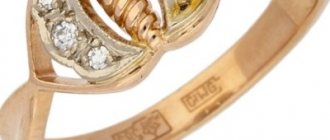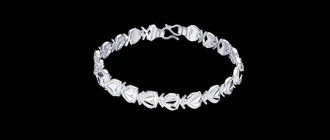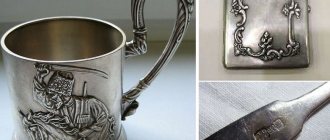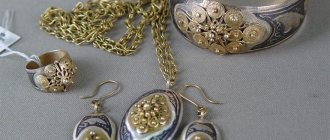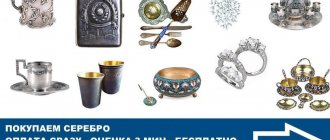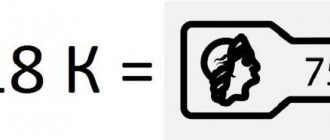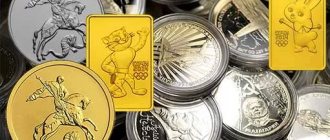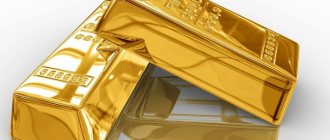Greetings, my beloved readers.
Today I want to talk about suspicious “white gold” with the number 875. Precious metals are a favorite tool of scammers. Passing off a low-grade item as exclusive jewelry is a common trick of scammers.
Thus, 875 silver is similar to white gold, and products made from it are often purchased by inexperienced buyers at an inflated price. I will tell you about the properties of this brand of noble metal and how not to confuse it with gold.
What kind of sample is this
Before describing the characteristics of the 875 alloy, I will explain the meaning of the term “sample”. Gold and silver are not cheap materials; they are very soft and difficult to process. If you wear jewelry made from pure metals, they will quickly wear out and lose their shape.
The high cost and softness of gold and silver led to the addition of impurities or alloys consisting of copper, less often platinum, zinc, cadmium or nickel.
Additives give the alloy hardness, elasticity, and change its color. To indicate the amount of gold or silver, the concept of “fineness” was introduced. In Russia, all alloys containing more than 30% precious metal are subject to assaying.
Composition and properties
The 875th sample contains 87.5% silver and 12.5% alloy. It has a dazzling white color, almost like pure silver, and is slightly oxidized in air. Copper is usually used as an impurity.
1 kg of 875th sample contains 875 grams of silver and 125 grams of copper. Copper increases hardness and gives the product a reddish tint.
Rarely, the following substances can be used as ligatures:
- cadmium – lowers the melting point and hardness;
- zinc – further reduces the melting point, as well as ductility;
- platinum – increases the elasticity and melting point of the substance;
- nickel – adds hardness, improves casting properties.
The use of platinum increases the cost of the product several times. Nickel and cadmium are not used in making silverware or jewelry as they are toxic. Over time, darkening forms on the surface of the metal.
A chemical reaction is to blame. Silver combines with sulfur compounds found in the environment or on the human body. As a result, blackening forms on the product - silver sulfide.
Strength
Thanks to impurities, items made from 875 are stronger than those made from pure silver. It is a kind of border between low-grade and sterling metal. Sterling silver starts at .925. Good strength allows you to create both cutlery and inexpensive jewelry from 875 standard.
Is it silver or gold?
If palladium or platinum is added to gold, the cost of the resulting alloy will be higher than in the case of copper. Its color will not be yellow, but white, similar to silver. Fraudsters take advantage of this similarity, passing off one metal as another. But how to distinguish them? This is where the mark on the product indicating the sample comes to the rescue.
Precious alloys have standardized hallmark lists. The table below shows their meanings.
| Silver, Ag | Gold, Au | Platinum, Pt | Palladium, Pd |
| 800 | 375 | 585 | 500 |
| 830 | 500 | 850 | 850 |
| 875 | 583 | 900 | |
| 925 | 585 | 950 | |
| 960 | 750 | ||
| 999 | 958 | ||
| 999 |
As can be seen from the table, if, for example, “875” is stamped on a ring, then it cannot be gold, since there is no 875 standard for this metal. This means the product is silver.
Alloy shade chart
Depending on the sample and ligature, the shade of the metal may vary. There are alloys below 600, they are used in production. Below is a table showing the dependence of the color of silver on the amount of impurity in the sample.
| Try | Color shade | Application |
| 600 and below | Red, due to the presence of large amounts of copper | Industry |
| 720 and 750 | Bright yellow | Tableware |
| 800 | Yellow | Dinnerware |
| 875 | Weak yellow | Dishes, decorations |
| 925 | White | High quality jewelry, commemorative coins |
| 960 | Bright white | Filigree, decorations |
| 999 | Bright white | Ingots |
In addition to copper, it is rare, but other alloys in silver are found. They make an additional contribution to the color scheme of the metal.
| Impurity | Introduced tint |
| Cadmium, Cd | Green |
| Zinc, Zn | White |
| Nickel, Ni | Pale yellow |
| Platinum, Pt | White |
The color change is mainly affected by the copper content of the silver. Other impurities are very rare in jewelry production.
Brand
Only the Russian State Assay Chamber has the right to apply a mark. In Russia you can find the following options for hallmarking silver 875:
- a sign in the form of a barrel with a head in a kokoshnik, looking to the right. The barrel is used to represent silver. To the left of the woman’s head is a letter indicating the territorial affiliation of the supervisory inspection. On the right is stamped the number 875, indicating the mass fraction of silver in the product;
- Soviet mark. From 1958 to 1994, the mark used in the USSR was affixed. It is similar to the Russian one, only instead of a woman’s head there was a star with a hammer and sickle. In the Soviet Union, the correspondence of the hallmark to the hallmark was strictly controlled, and jewelry products were of high quality, which cannot be said about many current jewelry. Therefore, “star” products are in great demand; they are valued more expensively in pawn shops;
- antique silver. In Tsarist Russia, the spool test was adopted. A spool is a measure of weight equal to 1/96 of a pound or approximately 4.3 grams. Pure metal without impurities had a purity of 96. Modern 875th silver corresponds to the 84th spool. Such numbers can be found on antique products. The photo below shows the old stamp.
In addition to the metric system for measuring precious metal, the carat standard is used in foreign countries.
How many carats are in this sample?
In the USA and Canada, the amount of precious metal in an alloy is measured in carats.
To avoid confusion with the metric system, one of the following abbreviations is placed after the numbers:
- K;
- kt;
- C;
- ct.
The correspondence between carat and metric standards is shown in the table.
| Metric system | Carat system |
| 375 | 9 |
| 500 | 12 |
| 600 | 14,4 |
| 625 | 15 |
| 750 | 18 |
| 770 | 18,5 |
| 800 | 19 |
| 830 | 20 |
| 875 | 21 |
| 900 | 21,6 |
| 916 and 925 | 22 |
| 940 | 22,56 |
| 950 | 22,8 |
| 960 | 23 |
| 970 | 23,28 |
| 999 | 24 |
According to the table, the 875th hallmark is equal to 21 carats. Now, looking at foreign items, you can easily determine the amount of silver in them.
Why does this question arise?
875 standard - what is it: gold or silver? Products made from it can often be mistaken for gold. This visual similarity is given by some metals included in the composition, in particular copper. It increases the elasticity and strength of the finished material, but a product of this composition requires some care, otherwise a dark coating appears, which negatively affects the appearance. Silver with 875 purity can also imitate white gold. Moreover, gold can be given a white color regardless of the height of the sample; the color will depend only on the composition of the impurities, that is, on the alloy. Also, do not forget about the list of numerical indicators for silver and gold, in which the number 875 refers to the first.
Here is the answer to the question that interests us: 875 silver is a very common marking of a precious metal alloy, products from which are of high quality. From everything that has been said previously, it follows that if it is 875 gold (the USSR and Russia use this standard), it cannot be. Only precious items made from a less noble metal have this designation.
Differences from 925 silver
Another common type of silver is 925. Its main features are a greater amount of noble metal and the absence of yellowness. It contains 92.5% silver, and therefore the products are more expensive.
Most jewelry is made from 925 grade metal. It is more flexible than 875 and allows you to create elegant, openwork accessories. It shines with a noble silver-white hue, which cannot be said about the 875 sample, which has a slight yellowness.
How to measure a sample?
There are two systems used to measure precious metal samples: metric and carat . In Russia, metric measurement of the quality of metals has been adopted since 1927. However, when buying jewelry abroad, you need to first familiarize yourself with the ratio of measurement scales for one and another method:
- 20 carats = 830 standard;
- 21 carats = 875th standard;
- 22 carats = 925th standard;
- 23 carats = 960th standard;
- 24 carats = 999th purity.
How can you recognize a fake?
There are several ways to determine whether it is silver or not:
- “lunar” metal has high thermal conductivity. If you hold it in your hand for a few minutes or put it in hot water for 10 seconds, it will quickly heat up to the temperature of your hand or water;
- Ag is not attracted to a magnet. If an object is magnetized, then it is not silver;
- sound and reflection of light. Silver is a very sonorous metal. If you drop a piece of jewelry from a meter high onto a hard floor, a loud vibrating sound will be heard. Silver also has a reflectivity of 96%, so it shines very brightly in the sun;
- if a low-quality product is sold, it will leave dark marks on the skin. To check, you need to rub it on the skin for about a minute and see the result;
- chalk can also be used for checking. Rub the silver with it. If dark stripes appear on the chalk, it means the metal is genuine;
- iodine testing. Drop iodine onto the item being tested. If it turns black, then it is silver. The disadvantage of such a test is that it is very difficult to remove the darkening later. If the stain turns out to be light, then it is not silver;
- Make a deeper scratch on the metal in an inconspicuous place. If there is material of a different color under the outer layer, it means the item was silvered. Drip vinegar into the groove formed. The appearance of green foam indicates a fake;
- Jewelry stores sell a kit with chemical reagents for testing silver. You can purchase a touchstone with it so as not to damage the object being tested. Then rub the test item on the stone. Drop the reagent from the kit onto the remaining trace. The quality of the product is determined by the resulting color. The color scheme is given in the table.
| Trace color | Sample metal |
| Scarlet, bright red | Silver 960 and above |
| Burgundy, dark red | Above 900 |
| Brown | Above 800 |
| Green | 700 and below |
| Blue | Nickel |
| Yellow | Lead, tin |
| Dark brown | Brass |
The Internet describes how to check with a lapis pencil. But I will question the relevance of this method, since finding a pencil now is problematic. Testing at home does not guarantee 100% accuracy. It is better to conduct it in a jewelry workshop or assay office.
Why do they fake it? Does 875 gold exist?
Externally, 875 silver differs little from white gold. The similarity effect can be achieved using a special coating - gilding. Unscrupulous sellers often pass off silver items as gold with an 875 marker. This way they increase the cost of jewelry: silver costs no more than 60 rubles per 1 gram, while the price of white gold starts from 5,000 rubles.
It is important to remember: there is no gold with such a marker.
How to distinguish a fake from a genuine product.
To be able to avoid the tricks of scammers and not pay the price of gold for a silver item, you need to remember the following differences:
- Price: too low a price for white gold jewelry is the first sign of deception. This is an expensive alloy, special sales and promotions rarely apply to it.
- Stamp: the borders of the image must be smooth and distinct, of the same depth, without dents or abrasions. It should have both a picture and a number. If there is no sample at all, this is a complete fake.
- Fastening elements: if there are stones on the jewelry, they must be carefully and securely fastened. Poor quality and negligence indicate falsification. Scratches are not allowed on genuine jewelry.
- Iodine test: if the purchase is in great doubt, conduct a test: drop a couple of drops of iodine on the surface. On silver the stain will begin to lighten, on gold it will darken.
- Magnet test: Silver is attracted to a magnet, but gold is not. Simple and fast.
- Certificate: In a licensed jewelry store, the seller must have documents. Read them carefully to understand which metal is the main one in the product.
Video: How to quickly test silver at home
Application of this alloy
Jewelry for undemanding customers is made from the material described. 875 is stronger than 925, so it is harder to process. Rings, chains, bracelets, rings - this is the assortment of the 875th sample. Gemstone inlays are not uncommon for this material as it can hold them.
Also, the 875th sample is used to make tableware and candlesticks. No matter what year it is, silver tableware always remains a prestigious feature. Back in the late 19th and early 20th centuries, many houses and restaurants were furnished with silver sets.
But with the increasing costs of their production, as well as the need for constant cleaning, they were supplanted by their more practical counterparts. Cigarette cases, ashtrays, cup holders, and shot glasses are now common.
Advantages and disadvantages
The advantages of the 875th sample include low cost. Using rhodium plating and plating, stylish, beautiful jewelry is obtained. You can flaunt such jewelry at banquets and social events. Low tendency to oxidation, blackening, strength are the positive aspects of the material.
Insufficient ductility and difficulty in processing are the weak points of 875 silver. It is more difficult to create elegant crafts from 875 standard than from sterling. Excessive hardness interferes with fine processing, so 875 silver is more often used in industrial jewelry production.
Brand “875”
In an alloy with 87.5% content, copper, germanium, silicon or platinum can be used as a master alloy. In its pure form, argentum is difficult to process. Alloying improves the properties of the product and is mandatory. Platinum has a significant impact on the final price of the product, so copper is used for this. It should be noted that items made from 875 sterling silver may become tarnished and tarnished over time, so they must be taken care of. Such silver is usually branded with an oval with cut off sides and the head of a woman in a kokoshnik.
Where can you buy or sell
You can buy 875-grade silver in numerous jewelry stores and pawn shops. Their addresses can be found on the Internet. Read reviews before purchasing. You can sell them in the same organizations.
How much does 1 gram of silver of this standard cost today?
The price changes every day and is set by the Central Bank of Russia. You can find it on the bank's website. Moreover, the price of the 999th sample is indicated. It needs to be multiplied by 0.875, and the cost of a gram will be 875 marks. For convenience, I suggest using a “live” graph and table.
| Price 999 standard according to the Central Bank | Market value of the sample today | Scrap price | Price in jewelry |
Prices
Knowing what types of silver there are, it is not difficult to guess the cost of objects made from this metal. A hallmark stamp on any silver item helps prevent fraud on the part of sellers and manufacturers.
To calculate the cost of silver depending on the sample, you need to know the price of one gram of pure precious metal. The rate for silver of the Central Bank of the Russian Federation is 30.95 rubles per gram.
Based on this, the price for one gram of silver is:
- 960 sample: 30.95 x 0.96 = 29.71 rubles;
- 925 sample: 30.95 x 0.925 = 28.63 rubles;
- 875 sample: 30.95 x 0.875 = 27.08 rubles;
- 830 sample: 30.95 x 0.83 = 25.69 rubles;
- 800 sample: 30.95 x 0.8 = 27.74 rubles.
Recommendations for care, cleaning and storage
Moon metal should be stored in a dry and dark place. Wear it more often. If the jewelry sits for a long time, it will fade faster. There is no need to dump all the items in one pile, as they will damage each other.
The main enemies of silver are:
- increased humidity and temperature;
- substances containing sulfur;
- paper or cardboard containers.
Jewelry needs to be cleaned periodically. There are several methods:
- Dilute ammonia with water in a ratio of 1:10. Place the silver in the solution for 15 minutes. Then remove and rinse in clean water, and finally wipe with a soft cloth;
- pour 50 g of soda into 1 liter of water and throw in a piece of foil. Place the products in the solution and boil them. Then rinse and dry;
- Pour 100 g of citric acid into 500 ml of water. Immerse the decorations and boil them for 20–30 minutes. Then rinse and dry;
- buy Johnson “Silver Quick” or Leuchtturm liquids in jewelry stores. Immerse the silver in them for a few minutes, then rinse and wipe.
If the jewelry has inlay, then such methods can harm it. In this case, it is better to contact jewelers.
Overview of species
When making a combined composition of the material, jewelers noticed that the way the metal looks depends on its ingredients. Through experimentation, not only various types of alloys emerged, but also methods for their decorative processing. The most popular types of silver are:
Blackened
The method of blackening appeared back in the days of Ancient Russia , when silver products were decorated with patterns of rich black color. If you combine sulfur, lead, copper and pure silver in certain proportions, you get a substance that in the old days was called “niello.” The finished product was subjected to artistic engraving, after which it needed to be heated until the blackening composition dissolved. The result of this work was a product that combines light silver and rich dark shades.
This method was used to decorate silver jewelry, household items, dishes, engravings, and so on. The demand for blackened silver was especially great in the 17th century. Products made from blackened silver alloy were particularly durable and did not require constant cleaning.
Oxidized
Another type of blackening, which was achieved by combining the metal Ag and the mineral S. Differing from blackened silver, oxidized blackening was not as durable, since blackening was achieved by obtaining a special oxide film, which quickly became unusable after cleaning the product. The cost of oxidized silver is the same as blackened silver, but when purchasing it was important not to confuse them with each other, since their coating resistance is different.
Thanks to the manufacturing technology, oxidized silver could produce shades of blackening from dark purple to black, and when polishing the product, the convex parts became shiny and light, and the concave parts of the pattern had the effect of blackening a certain shade.
Oxidized blackening is usually used to decorate small-sized items - earrings, pendants, pendants, chains or bracelets.
Matte
It is obtained by removing the natural metallic sheen from the product, which gives it a certain sophistication and resistance to darkening. This effect is achieved by sandblasting the product or etching the silver in special chemical solutions.
Gold plated
It is obtained by applying a thin layer of gold to a silver alloy . This treatment adds value to the finished product, gives it a sophisticated look and increases natural resistance to oxidative processes. Gilding is applied not only to jewelry, but also to cutlery , which can withstand being placed in an acidic and salty environment and do not lose their original appearance, whereas a product made from ordinary silver would react by changing color.
In addition to the methods listed above, silver is decorated with enamel or alloyed with rhodium metal. This silver looks especially bright and is distinguished by its pronounced white color.
Tips for choosing silver jewelry
Silver jewelry, although an inexpensive accessory, can look very impressive if chosen correctly.
Some tips for choosing them:
- You need to buy from trusted stores. The product must have a clearly visible sample and a sealed tag;
- You must first try on the product. If this is a ring, then you need to know the exact size;
- silver is especially suitable for fair skin, blue or gray eyes, black or platinum hair;
- If there is an official event, a business meeting, or a trip to the beach, then silver items are preferable.
Of the stones, white metal is best combined with emerald, sapphire, lapis lazuli, agate, amethyst, onyx, and malachite. But it is not friendly with zircon, amber and tourmaline.

